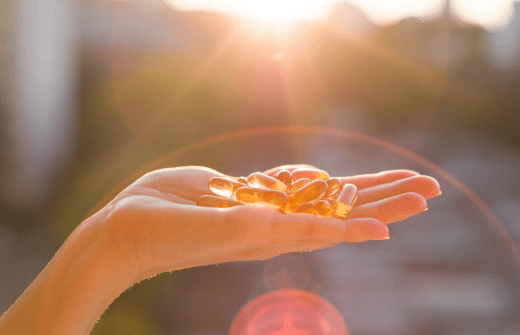Iron is one of the essential trace elements in the body. Its need is relatively low, but still essential to maintain our health. Iron performs a number of important functions in the body, for example it is part of the red blood pigment hemoglobin and is involved in oxygen transport. Iron deficiency can result in fatigue but also in more serious health complications. The human body cannot synthesize iron on its own and we are therefore dependent on iron intake from the diet. However, it is important to remember that not only iron deficiency, but also excessive iron intake can cause health problems.
Article at a glance:
- What roles does iron play in the body and where is it found in the body?
- Anemia and the manifestations of iron deficiency
- Iron supplementation and its risks
- Supplementing iron naturally from food
- What affects iron absorption?
- Risk of iron supplementation during infectious disease
What roles does iron play in the body and where is it found in the body?
Iron is crucial for our health! It maintains the normal function of the immune system as it is needed for the proliferation and maturation of immune cells. It is also important for the normal production of red blood cells and hemoglobin, which transports oxygen from the lungs to all parts of the body. We also need it for the proper functioning of the thyroid gland - it is necessary for both the synthesis and metabolism of thyroid hormones. [1] Last but not least, iron participates in the human body as a cofactor in many enzymatic reactions.
Below is a simplified overview of the distribution of iron in the human body.
- Approximately 60-70% of iron is found in circulating red blood cells as part of the blood pigment hemoglobin.
- Approximately 20-30% of iron is stored in the liver in the storage form of ferritin and hemosiderin. From these stores, iron can be released into the bloodstream when needed. Ferritin is therefore an indicator of the iron status of the body.
- 5-10% of the body's iron is found in myoglobin, the protein that provides oxygen to the muscles.
- Approximately 1-5% of iron is found as part of various enzymes and cofactors.
- Only less than 1% of iron is found in transferrin, a protein that transports iron through the bloodstream.
Anemia and the manifestations of iron deficiency
Iron deficiency is one of the most common nutritional deficiencies worldwide and is the most common cause of anemia. It is estimated that about 2 billion people worldwide, a quarter of the world's population, suffer from iron deficiency anaemia. [2]
Iron deficiency anemia is characterized by small red blood cells. There may be plenty of red blood cells, but they are small, do not have enough hemoglobin and so the blood carries less oxygen. This leads to typical symptoms such as fatigue, pallor, shortness of breath or cold extremities. Other symptoms of iron deficiency include brittle nails, hair loss, reduced concentration, insomnia or immune disorders.
The cause of iron deficiency anemia needs to be identified. It may be due to low dietary iron intake, blood loss (e.g. heavy menstrual bleeding or gastrointestinal bleeding), but also, for example, intestinal disease where the patient is unable to absorb the iron received. However, there may be more than one reason for anemia and iron deficiency is not always the cause. A deficiency of vitamin B12 or folate can also cause anemia. This type of anemia is characterized by fewer large blood cells and is known as megaloblastic anemia.
People at risk of iron deficiency and anemia include menstruating women, pregnant women, young children, vegetarians, frequent blood donors, people with inflammatory bowel disease or those who have had a gastric resection.
Iron supplementation and its risks
Although many people may appear to be iron deficient based on their symptoms, hasty supplementation can be dangerous. Iron supplementation is only appropriate when there is evidence of iron deficiency. This is because our body is not equipped with any mechanism to eliminate excess iron.
Balanced iron levels in the body are mainly controlled by the regulation of iron absorption in the small intestine, which is influenced by many mechanisms, with the hormone hepcidin playing a crucial role. However, the production and function of this key hormone is also affected by certain genetic mutations that can ultimately lead to excessive iron absorption in the body (hemochromatosis). For this reason, it is not wise to add iron to every multivitamin without knowing the nutritional profile and individual genetic polymorphisms. Such multivitamin could be dangerous for some people due to the added iron.
Excess iron in the body places a burden on the body - it increases oxidative stress, can damage DNA molecules, lead to premature aging and the development of other diseases. [3] Toxic iron excess can occur when iron supplements are overdosed. Symptoms of poisoning include abdominal pain, nausea, vomiting or diarrhea. Young children are especially at risk of acute iron poisoning as they may mix up iron tablets for candy.
Therefore it is not advisable to use an iron-containing multivitamin without knowing whether we are deficient in iron, or not. Our multivitamin Daily F20 Complex, which is intended for long-term use, deliberately does not contain iron. However, if it is a specialized multivitamin, for example for pregnant and breastfeeding women or for athletes who may have increased demands on their iron intake, the presence of iron in the formula can be important.
Supplementing iron naturally from food
Iron is found in two forms in food, heme iron and non-heme iron. Heme iron is found in animal products, and organ meats and red meat are among the richest sources. This type of iron is more readily absorbed.
The non-heme form of iron is abundant in plant sources, but is also found in animal products. This form is less absorbable and less usable. Thus, it appears that people with a diet low in heme iron (vegetarians or vegans) are at greater risk of iron deficiency and anaemia. [4]
What affects iron absorption?
Iron absorption is affected by many factors. Iron absorption is governed by the body's demand. In cases of higher iron demand (for example during pregnancy), iron absorption is higher. Conversely, its absorption decreases with age.
As for non-heme iron, an acidic stomach environment with sufficient hydrochloric acid is required for proper absorption. Therefore, people taking drugs that reduce stomach acidity (antacids or proton pump inhibitors) will find it harder to absorb iron from their diet.
Dietary factors also play a major role in the absorption of plant iron. Phytates, which are abundant in cereals and legumes, form insoluble complexes with iron and make it difficult to absorb. However, by appropriate preparation of legumes and cereals (e.g. sprouting), the amount of these antinutrients is reduced. Absorption of non-heme iron is also reduced by oxalates, large amounts of dietary fiber or, for example, caffeine or tea. Calcium acts as an antagonist, meaning that it competes with iron for binding sites. The absorption of plant iron, on the other hand, is promoted by vitamin C, so it is advisable to eat meat with vegetables, sprinkle legume dishes with lemon or just add leafy greens. Also, the combination of heme and non-heme iron increases the absorption.
To avoid possible iron deficiency, it is not recommended to consume dairy products together with iron-rich foods. Iron supplements should be taken on an empty stomach and you should avoid drinking coffee, tea or milk with iron supplements.

Risk of iron supplementation during infectious disease
Finally, it is important to mention that iron supplementation is not appropriate during acute inflammation or infectious disease. The growth and multiplication of many bacteria depend on iron intake and there is a proven link between iron availability and the ability of pathogens to cause disease. Thus, conditions associated with iron excess may increase the risk of infection. [5] [6]
Sources:
[1] Chatterjee, S., Chakrabarti, P., & Sinhamahapatra, P. (2021). Relationship between iron metabolism and thyroid hormone profile in hypothyroidism. International Journal of Research in Medical Sciences, 9(3), 790–793.
[2] Peyrin-Biroulet L, Williet N, Cacoub P. Guidelines on the diagnosis and treatment of iron deficiency across indications: a systematic review. Am J Clin Nutr. 2015 Dec;102(6):1585-94. doi: 10.3945/ajcn.114.103366. Epub 2015 Nov 11. PMID: 26561626.
[3] Yuen HW, Becker W. Iron Toxicity. [Updated 2023 Jun 26]. In: StatPearls [Internet]. Treasure Island (FL): StatPearls Publishing; 2023 Jan-. Available from: https://www.ncbi.nlm.nih.gov/books/NBK459224/
[4] Pawlak R, Berger J, Hines I. Iron Status of Vegetarian Adults: A Review of Literature. Am J Lifestyle Med. 2016 Dec 16;12(6):486-498. doi: 10.1177/1559827616682933. PMID: 30783404; PMCID: PMC6367879.
[5] Sanda I. Patruta, Walter H. Hörl, Iron and infection, Kidney International, Volume 55, Supplement 69, 1999, Pages S125-S130, ISSN 0085-2538, https://doi.org/10.1046/j.1523-1755.1999.055Suppl.69125.x.
[6] Pieracci FM, Barie PS. Iron and the risk of infection. Surg Infect (Larchmt). 2005;6 Suppl 1:S41-6. doi: 10.1089/sur.2005.6.s1-41. PMID: 19284357.

















